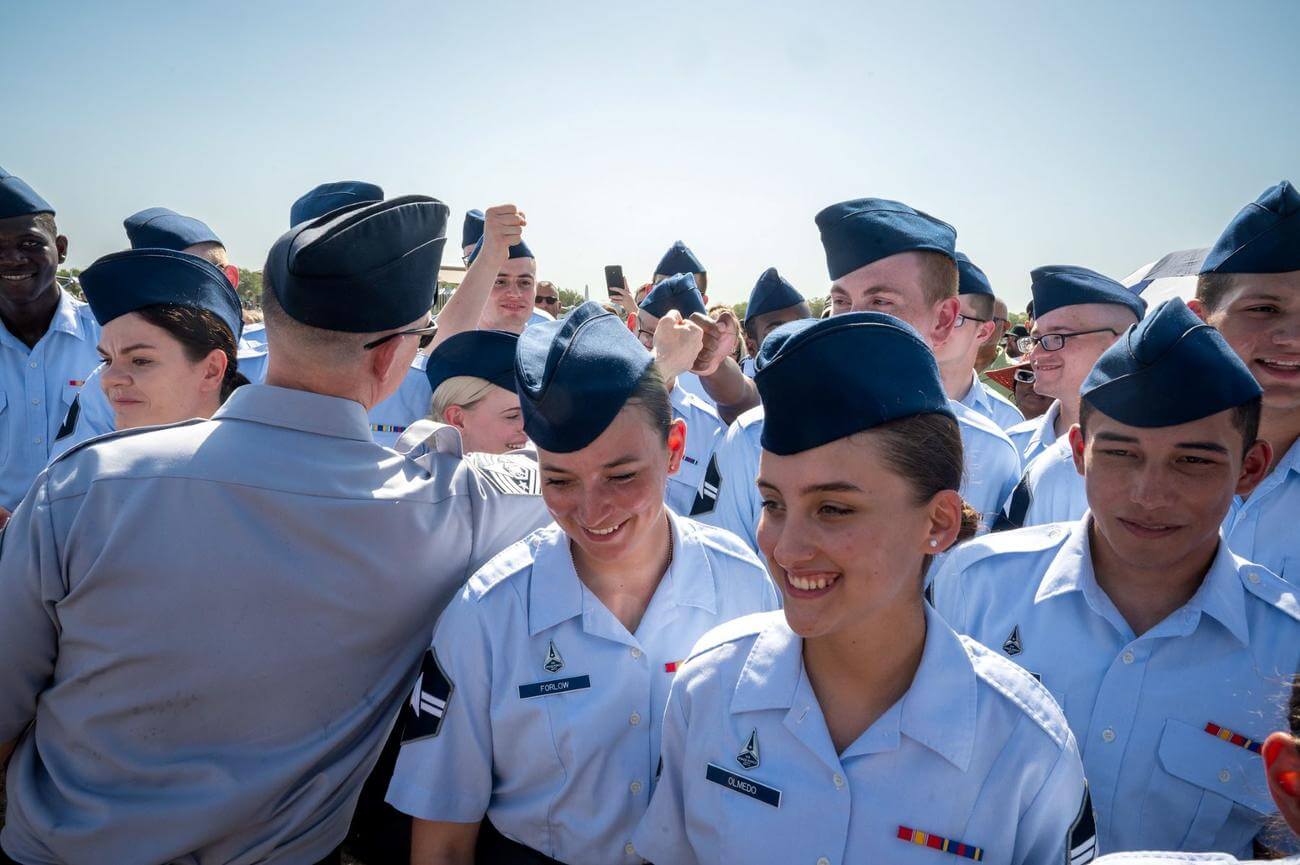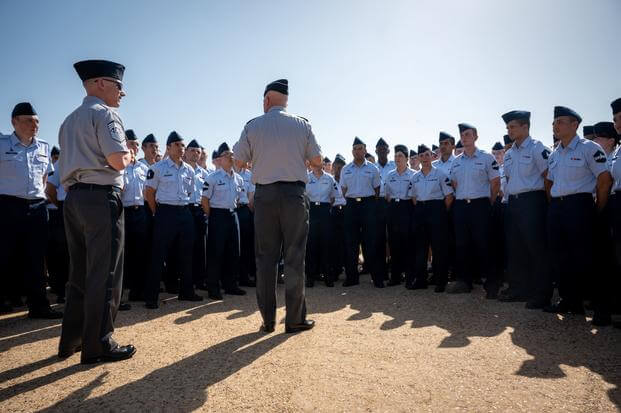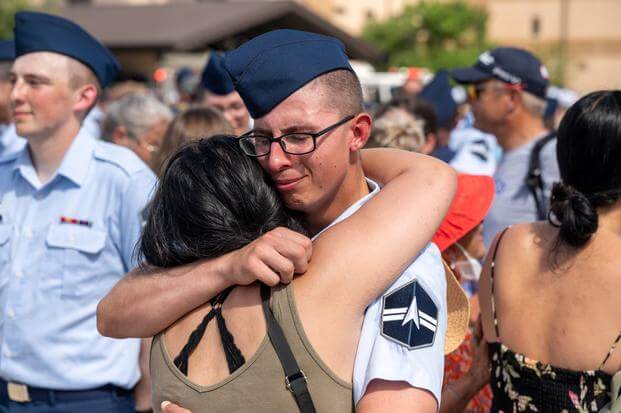
This is the final story in a three-part series that follows recruits through the first-ever boot camp just for Space Force Guardians. Over three months, Military.com interviewed more than a dozen Guardians, drill sergeants, recruiters and officers, and visited the two-month basic training in Texas to show the new Guardians’ path from the recruitment office to graduation day. You can read Part 2 here and Part 1 here.
Gen. John Raymond stood at a podium, the Texas sun shining down, and looked out at Joint Base San Antonio-Lackland’s parade field. In front of him stood 71 Space Force Guardians decked out in navy and light blue dress uniforms for their June 23 graduation day.
For some, the Space Force offered a second chance at service.
Jesse Costello, an 18-year-old recruit from Buffalo, New York, stood with his classmates only weeks after he had been cleaved from the group of other burgeoning Guardians, forced to reflect quietly alone in his barracks and not train while officials reviewed a medical issue. His drill instructors weren’t sure if he would be given a waiver that would allow him to join the force.
He had always dreamed of becoming an Air Force pilot, but a different medical issue, a hearing problem, kept him from being able to join that service. He was encouraged to enlist in the Space Force instead and boarded a bus for San Antonio on May 3.
But on graduation day, he held up his right hand as he repeated the oath of enlistment. The 18-year-old had been cleared for military service, and his long-awaited dream of serving his country finally came true.
Two months earlier, he and 71 recruits had arrived from all over the country to make history as the inaugural class in the first basic training done solely by the new service branch. Raymond, who has led the Space Force since its inception, surveyed the newly minted troops with their glistening silver pins, a symbol of his vision for what the service could become.
They came with higher test scores and underwent more classroom work than other recruits. Instead of being broken down to be reformed, characterless clay molded as other branches have historically viewed recruits, they were trained in a boot camp culture of acceptance with their existing skills fostered. It was a group of geeks, athletes, immigrants and quiet band kids who are being sent out to defend America’s satellites. It was a group that looks different from any other cluster of boot camp graduates in the other service branches.
Maria Pryde, 32, a recent immigrant from Belarus, was there among the graduates, her aspirations to help protect the world by serving as a Guardian now in reach. Sebastian Montesdeoca, 24, a Colombian-born athlete who played college football, had also made it to graduation day.

Only one recruit hadn’t passed through the training, which tracked with the Space Force’s low attrition rate compared to the other services for prior versions of its boot camp.
“As I spent time reviewing your stories and reasons for joining the military, I found myself in awe of what you’ve already accomplished and how passionate you are to serve,” Raymond told the Guardians arrayed in front of him. “You are a cross-section of our nation, representing all walks of life. We have prior Starbucks baristas, Advanced Placement and NASA scholars, Python programmers, state soccer champions, hurricane survivors, new high school graduates, many bachelor’s and even a few master’s degrees.”
The seven-and-a-half weeks of basic training were now in the rearview mirror, with the new Guardians set to head off to assignments as the service jockeys for influence and resources among the other service branches.
The Space Force, a separate service under the Department of the Air Force that mirrors the Marine Corps‘ relationship with the Navy, had been floated as a concept in Washington since the 1970s. Its mission — to protect and defend the massive U.S. satellite fleet — is crucial in everything from detecting missiles being launched by enemies around the globe to managing the country’s network of Global Positioning System satellites that help every military service conduct reconnaissance missions across the world.
But the Space Force — the first new military service branch since 1947 — still faces headwinds and uncertainty as it seeks to eventually run its boot camp on one of its own bases, and continues to carve out its own identity just a few years after being created after aggressive advocacy from then-President Donald Trump in 2019. Congress has sought to limit its scope, and leaders are still hashing out its ultimate shape, such as what may comprise the reserve component.
Military.com spent two days on the ground in Texas and was granted access to the basic training, including interviews with recruits who shared their experiences. The journey of the recruits in the first flight of the Space Force-run boot camp offers a window into the service at a crucial moment in its development and history as it works to carve out its own traditions, gain a footing and forge an identity separate from its sister service, the Air Force.
Making the Cut
The hugs between Guardians and their loved ones after graduation were short-lived. Most weren’t aware of the larger political forces at play that will shape what the Space Force becomes as they piled into minivans and cars to eat their first meal outside of the base walls in nearly two months, a tussle over resources and mission that helped stall the creation of the branch.
Within days, many of them would be shipping out to their training schools to learn operations, intelligence, engineering, cyber or acquisitions.
Costello, who was headed into an intelligence career field, was reflecting on his first couple of weeks in basic training and on what advice he should take with him into his new military career.
When he feared his medical issue was going to be flagged, he focused on something repeated frequently by one of the drill instructors, Master Sgt. Eric Mistrot.
The phrase was “make it make sense.”
It was usually uttered as a response when the Guardians were confused or uncertain about packing their footlockers or figuring out how to walk in step.
Callum Tizard, a 21-year-old from Arizona who surrendered his Scottish citizenship to become an American and join the military, had been highlighted by drill instructors as the person who best embodied courage and was also named the honor graduate among the 71 Guardians — meaning he tested and scored the highest among all the recruits.
As part of a new tradition for the military service, instructors had recognized four of the recruits who best embodied the core values taught during boot camp: character, connection, commitment and courage.
Prior to graduation, Tizard told Military.com that during boot camp, he realized the Space Force is what was missing from his life. And with the optimism that most newly enlisted service members possess, he wants to make a career out of it.
“This is what I want to do,” Tizard said. “I want to retire from doing this. I want to be in the military; this was just it for me.”
This graduation cycle, with only one Guardian who didn’t make it through, the washout rate was around 1.5%. That’s low even compared to the high graduation rate of earlier Guardians who went through basic training alongside airmen. The annual attrition rate on average for Space Force has been 5% while the Air Force, Army, Marines and Navy range from around 7% to as high as 15%.
Another Guardian, whose identity was not disclosed to Military.com by the service, did not make it through boot camp because of a medical issue, according to a spokeswoman.
Other recruits who had struggled with the Space Force fitness standards were given a lifeline. If they failed the 1.5 mile run, push-ups or sit-ups and still passed every other standard, the Space Force would grant that recruit 180 days to pass a physical training test.
Every Guardian passed their physical training evaluation prior to graduating, according to Col. Erin Dick, a spokeswoman for Space Training and Readiness Command.
Whatever hardships they endured, the Guardians will look back fondly on the experience in 15 or 20 years, possibly after retirement, said Col. Jeffrey W. Pixley, the commander of the 737th Training Group at Joint Base San Antonio-Lackland who oversees all basic military training at the installation.
“When they go back to visit where they went through basic training, it’s going to be a magical place,” Pixley said. “It’s going to be a place that makes them feel a certain way.”
Space Force’s leadership wants to make future classes have an even more Guardian-specific experience.
Raymond and Chief Master Sgt. Roger Towberman, the Space Force’s top enlisted leader, told Military.com in an interview that they would like the service’s boot camp to move to a Space Force base in the future.
The two leaders, who have been instrumental in forming the nascent force, said they see the move as an essential part of shaping its identity.
“I certainly would embrace an opportunity to ensconce them in a Space Force environment on a Space Force base where they would be surrounded by Guardians and we’d really feel from day one like they were part of this special thing that we’re trying to build,” Towberman told Military.com. “So, we’ll work through that in time, but certainly there are advantages.”
The Political Battles Ahead
The boot camp, seen as a success by the service, reinforced that Space Force’s mission is unique from the other branches, and leaders are trying to embrace that as they recruit the next crop of Guardians and build out the basic training program.
But the efforts have also been met with outside criticism.
The Space Force is floating the idea of using wearable fitness trackers, for example, instead of running a punitive physical training program. Some veterans on social media lambasted the idea due to concerns about data privacy and creating a less rigorous culture when it comes to health.

There has been similar public sniping at the more traditional aspects of the Space Force boot camp, such as its requirements for assembling a gun, marching and going on a mock deployment, because the force mostly stays in offices or on bases for their missions.
Despite the critics, Towberman said it’s important to think differently, especially when America’s enemies such as China and Russia are doing the same. To him, space is just like any other battlefield, and it shouldn’t be met with jokes.
“We put those weapons in human beings’ hands so that they remember this isn’t a game; we’re in a serious business,” Towberman said. “And there are serious threats out there, and we need to be prepared. And that applies to the space domain just like every other domain.”
Still, the service may be constrained when it comes to future visions, and there remains a debate over the eventual size and scope of the Space Force that Pryde, Montesdeoca, Tizard and Costello have joined.
The debate leading up to Space Force’s founding always revolved around whether it was worth creating all the infrastructure of a separate branch to oversee space when the responsibilities and assets were already managed by the other services. Those other services jealously guard funding and the responsibilities that justify that cash flow, and having to surrender anything to a different, fledgling branch inevitably carried political ramifications.
The Space Force was congressionally funded and created to be “lean and agile,” Gen. Raymond said. That also translates to an equally thin budget in comparison to the other armed services.
The Space Force has around 8,000 active-duty Guardians and nearly as many civilian employees, making a total force of around 16,000. By comparison, the Coast Guard has around 40,000 members, and the Marine Corps has around 180,000, both of which are tiny compared to the Army and Navy.
Size rather than time will likely decide whether the Space Force ever realizes goals like a separate boot camp on its own base, Robert Farley, a professor at the University of Kentucky who researches national security and intelligence with a focus on the service, said.
“I think the issue here is, the Space Force is just so small at this point that it’s really hard for them to try to justify having a lot of these sort of ancillary functions that the other services have,” Farley told Military.com.
Even before the June graduation, Congress was signaling turbulence ahead for the service’s growth aspirations.
This spring, the Space Force asked for $24.5 billion for their 2023 budget request — a more than 40% increase from the previous year — with a majority of the funds projected to go to research and development as well as establishing more missile warning systems.
But the House Appropriations Committee filed a report in June warning the newest military branch “against starting more programs than it can afford” and reminded it that its funding should start to decline slowly by 2027.
Leadership inside the Pentagon could also have a dramatic effect on the Space Force’s future. Air Force Secretary Frank Kendall has said publicly the service should be “tightly coupled” to the Air Force to survive, seeking to emulate the relationship the Marine Corps has with the Navy.
Kendall also said the new service shouldn’t focus on space as an “independent warfighting domain” and should instead view their mission as being a support organization for the other branches. The comments appeared to throw cold water on some of the core efforts by the service to grow and mature into its own unique branch.
Rep. Jim Cooper, D-Tenn., who helped lead the effort on Capitol Hill to create the Space Force, said wrangling inside the Pentagon could derail progress by Raymond.
“I’m worried about the Air Force trying to exert too much control and in some cases to stifle the development of the Space Force,” Cooper said during an Air Force Association panel in May.
Adding to that uncertain future is speculation that Raymond may be retiring this year from the service he has helped define. He declined to comment on the reports about his potential retirement during the interview with Military.com.
“I’ll just say I come to work every day focused on getting this right,” Raymond said.
But on June 23, as Raymond looked over the new Guardians on the Texas parade field, he was celebrating. He walked around to shake hands and take selfies after the speech and ceremony.
“On all accounts, we’ve made really good progress,” Gen. Raymond later told Military.com. “I will tell you, though, we still have a lot of work to do.”
— Thomas Novelly can be reached at [email protected]. Follow him on Twitter @TomNovelly.
Read Part 2: How Do You Create a Guardian? A Look Inside Space Force’s First Specialized Basic Training
© Copyright 2022 Military.com. All rights reserved. This material may not be published, broadcast, rewritten or redistributed.
